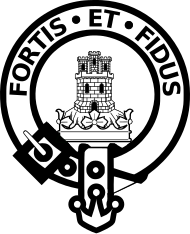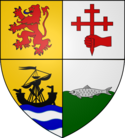Clan MacLachlan
| ||||||||||||||||||||
| ||||||||||||||||||||
| ||||||||||||||||||||
MacLachlan (Gälischer Name: MacLachlainn; gälisch: Sohn des Lachlan) ist der Name eines schottischen Clans.
Geschichte
Der MacLachlan-Clan entstand aus dem Kreis der Nachkommen des irischen Königs Niall of the Nine Hostages, circa 400 n. Chr. Im 13. Jahrhundert taucht der Name Lochlainn erstmals in Schottland auf, als Lachlan Mor sich am Loch Fyne in Schottland ansiedelt. Nach ihm sind auch heute noch Lachlan Water, Lachlan Bay, das Dorf Strathlachlan und das Castle Lachlan benannt. Im 15. Jahrhundert war der MacLachlan-Clan aufgrund ihrer engen Bindung zur Kirche bekannt. Politische Macht erlangte der Clan durch die mächtige Allianz mit dem direkten Nachbarclan, den Campbells.
Die Unterstützung der Stuarts
Zu Berühmtheit gelangte der MacLachlan-Clan durch seine Loyalität zu den Stuarts. Bereits der im Exil lebende James Francis Edward Stuart wurde von dem Clan unterstützt. Lachlan MacLachlan, der 17. Clanchef, war ein enger Vertrauter von Prinz Charles Edward Stuart und zog für ihn mit einem 300 Mann starken Heer 1746 in die Schlacht von Culloden gegen die Engländer. Das Heer der Highlander wurde vernichtend geschlagen, Lachlan MacLachlan kam ums Leben. In den Nachwehen der Schlacht wurde das Castle Lachlan niedergebrannt und die Clanfamilie musste fliehen. Durch das starke Bündnis mit dem Campbell-Clan blieb das Land der Maclachlans erhalten, sodass ein neues Castle Lachlan gebaut und der Clan an seinen Platz zurückkehren konnte.
Bilder
Weblinks
Auf dieser Seite verwendete Medien
Autor/Urheber: Celtus (Celtus @ english wikipedia), Lizenz: CC BY-SA 3.0
The copyright for this representation of the Scottish crest badge is held by the author of this image. In Scotland, the usage of heraldry is governed by legal restrictions, independent of the status of the depiction shown here. The crest and motto elements of the crest badge are always the heraldic property of an individual (the crest badges, used by most Scottish clan members, are usually the heraldic property of a clan's chief). Though a crest badge can be freely represented, in Scotland it cannot be appropriated or used in such a way as to create a confusion with or a prejudice to its owner.
Autor/Urheber: Celtus, Lizenz: CC BY-SA 2.5
A representation of the Maclachlan tartan. This is most popular Maclachlan tartan today. This tartan appears in the T. Smibert's The Clans of the Highlands of Scotland published in 1850. [1]
Thread count used: R32, K4, R4, K4, R4, K32, B32, G6, B32, K32, R32, K4, R4.
Autor/Urheber: Celtus, Lizenz: CC BY-SA 2.5
A representation of the Maclachlan hunting tartan. This tartan is the oldest tartan to bear the name MacLachlan. This tartan is referred to as the Old MacLachlan, MacLachlan, and Hunting MacLachlan. This sett was first published in Old & Rare Scottish Tartans by D. W. Stewart in 1893.
Thread count: Y6, W4, Bk32, G32, Y6, W4, R48.
Sources: MacLachlan Clan Tartan WR1710 MacLachlan Hunting Tartan









